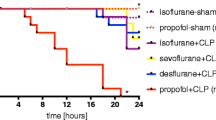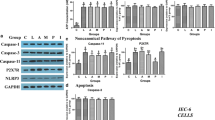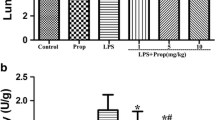Abstract
Nuclear factor kappa B (NF-κB) plays a central role in regulating the transcription of several genes associated with sepsis/septic shock. Therefore, the author investigated the effects of propofol on the plasma tumor necrosis factor α and interleukin 6 (TNF-α and IL-6) levels and NF-κB activation during polymicrobial sepsis in rats. Male Sprague-Dawlay rats were subjected to cecal ligation and puncture (CLP, a model of polymicrobial sepsis) or sham operation. The animals were randomly assigned into four equal groups (n = 10): sham CLP group, CLP group, PPF (propofol) I group and PPF II group. Thirty minutes before CLP, propofol (5 and 10 mg kg−1 h−1, respectively) was infused continuously through the left femoral vein cannula in PPF I group or PPF II group, CLP group and sham CLP group receiving 0.9% saline only at the rates of 5 ml kg−1 h−1. The right femoral artery was cannulated to monitor mean arterial pressure (MAP) and heart rates (HR). CLP produced progressive hypotension and a first increase followed by a decrease in HR. The plasma TNF-α and IL-6 levels and the hepatic NF-κB activation significantly increased after CLP alone. Compared with CLP group, propofol treatment reversed hypotension, slightly steadied heartbeats, and decreased the plasma TNF-α and IL-6 levels, and significantly suppressed NF-κB activation. Propofol has inhibited the hepatic NF-κB activition and the pro-inflammatory cytokine response during polymicrobial sepsis in rats.





Similar content being viewed by others
References
Matot I, Sprung CL (2001) Definition of sepsis. Intensive Care Med 27:S3–S9. doi:10.1007/PL00003795
Remick DG (2007) Pathophysiology of sepsis. Am J Pathol 170:1435–1444. doi:10.2353/ajpath.2007.060872
Tergaonkar V (2006) NFkappaB pathway: a good signaling paradigm and therapeutic target. Int J Biochem Cell Biol 38:1647–1653. doi:10.1016/j.biocel.2006.03.023
Higuchi Y, Kawakami S, Hashida M (2008) Development of cell-selective targeting systems of NFkappaB decoy for inflammation therapy. Yakugaku Zasshi 128:209–218. doi:10.1248/yakushi.128.209
Takemoto Y (2005) Dose effects of propofol on hemodynamic and cytokine responses to endotoxemia in rats. J Anesth 19:40–44. doi:10.1007/s00540-004-0267-z
Hsu BG, Yang FL, Lee RP, Peng TC, Chen HI (2005) Effects of post-treatment with low-dose propofol on inflammatory responses to lipopolysaccharide-induced shock in conscious rats. Clin Exp Pharmacol Physiol 32:24–29. doi:10.1111/j.1440-1681.2005.04155.x
Luo T, Xia Z, Ansley DM, Ouyang J, Granville DJ, Li Y, Xia ZY, Zhou QS, Liu XY (2005) Propofol dose-dependently reduces tumor necrosis factor-alpha-Induced human umbilical vein endothelial cell apoptosis: effects on Bcl-2 and Bax expression and nitric oxide generation. Anesth Analg 100:1653–1659. doi:10.1213/01.ANE.0000150945.95254.D8
Wichterman KA, Baue AE, Chaudry IH (1980) Sepsis and septic shock-a review of laboratory models and a proposal. J Surg Res 29:189–201. doi:10.1016/0022-4804(80)90037-2
Andrews NC, Faller DV (1991) A rapid micropreparation technique for extraction of DNA-binding proteins from limiting numbers of mammalian cells. Nucleic Acids Res 19:2499. doi:10.1093/nar/19.9.2499
Taniguchi T, Yamamoto K (2005) Anti-inflammatory effects of intravenous anesthetics on endotoxemia. Mini Rev Med Chem 5:241–245
Gao J, Zeng BX, Zhou LJ, Yuan SY (2004) Protective effects of early treatment with propofol on endotoxin-induced acute lung injury in rats. Br J Anaesth 92:277–279. doi:10.1093/bja/aeh050
Chen HI, Hsieh NK, Kao SJ, Su CF (2008) Protective effects of propofol on acute lung injury induced by oleic acid in conscious rats. Crit Care Med 36:1214–1221. doi:10.1097/CCM.0b013e31816a0607
Takenaka I, Ogata M, Koga K, Matsumoto T, Shigematsu A (1994) Ketamine suppresses endotoxin-induced tumor necrosis factor alpha production in mice. Anesthesiology 80:402–408. doi:10.1097/00000542-199402000-00020
Hoff G, Bauer I, Larsen B, Bauer M (2001) Modulation of endotoxin-stimulated TNF-alpha gene expression by ketamine and propofol in cultured human whole blood. Anaesthesist 50:494–499. doi:10.1007/s001010100149
Adams HA (1995) Analgesia and sedation on patients with sepsis syndrome. Anaesthesist 44(Suppl 3):S573–S579. doi:10.1007/s001010050193
Tsao CM, Wu CC, Wang JJ, Wong CS, Tsai SK, Ho ST (2005) Intravenous anesthetics in sepsis. Acta Anaesthesiol Taiwan 43:153–163
McGuinness OP, Lacy DB, Ejiofor J, Bagby GG (1996) Hepatic release of tumor necrosis factor in the endotoxin-treated conscious dog. Shock 5:344–348. doi:10.1097/00024382-199605000-00006
Sun J, Li F, Chen J, Xu J (2004) Effect of ketamine on NF-kappa B activity and TNF-alpha production in endotoxin-treated rats. Ann Clin Lab Sci 34:181–186
Jawan B, Kao YH, Goto S, Pan MC, Lin YC, Hsu LW, Nakano T, Lai CY, Sun CK, Cheng YF, Tai MH, Eng HL, Wang CS, Huang CJ, Lin CR, Chen CL (2008) Propofol pretreatment attenuates LPS-induced granulocyte-macrophage colony-stimulating factor production in cultured hepatocytes by suppressing MAPK/ERK activity and NF-kappaB translocation. Toxicol Appl Pharmacol 229:362–373. doi:10.1016/j.taap.2008.01.044
Yagmurdur H, Aksoy M, Arslan M, Baltaci B (2007) The effects of propofol and ketamine on gut mucosal epithelial apoptosis in rats after burn injury. Eur J Anaesthesiol 24:46–52. doi:10.1017/S0265021506000986
Feng X, Yan W, Wang Z, Liu J, Yu M, Zhu S, Xu J (2007) Hydroxyethyl starch, but not modified fluid gelatin, affects inflammatory response in a rat model of polymicrobial sepsis with capillary leakage. Anesth Analg 104:624–630. doi:10.1213/01.ane.0000250366.48705.96
Santos LL, Morand EF (2006) The role of macrophage migration inhibitory factor in the inflammatory immune response and rheumatoid arthritis. Wien Med Wochenschr 156:11–18. doi:10.1007/s10354-005-0243-8
Wu GJ, Chen TL, Ueng YF, Chen RM (2008) Ketamine inhibits tumor necrosis factor-alpha and interleukin-6 gene expressions in lipopolysaccharide-stimulated macrophages through suppression of toll-like receptor 4-mediated c-Jun N-terminal kinase phosphorylation and activator protein-1 activation. Toxicol Appl Pharmacol 228:105–113. doi:10.1016/j.taap.2007.11.027
Misch EA, Hawn TR (2008) Toll-like receptor polymorphisms and susceptibility to human disease. Clin Sci 114:347–360. doi:10.1042/CS20070214
Mantell LL, Parrish WR, Ulloa L (2006) Hmgb-1 as a therapeutic target for infectious and inflammatory disorders. Shock 25:4–11. doi:10.1097/01.shk.0000188710.04777.9e
Abraham E (2005) Alterations in cell signaling in sepsis. Clin Infect Dis 7(suppl):S459–S464. doi:10.1086/431997
Acknowledgments
This study was supported in part by the Natural Science Foundation of Hubei Province of China (No. 2002AB147). Institutional Animal Care and Use Committee, Wuhan University approved all the animal studies.
Author information
Authors and Affiliations
Corresponding author
Rights and permissions
About this article
Cite this article
Song, XM., Wang, YL., Li, JG. et al. Effects of propofol on pro-inflammatory cytokines and nuclear factor kappaB during polymicrobial sepsis in rats. Mol Biol Rep 36, 2345–2351 (2009). https://doi.org/10.1007/s11033-009-9456-z
Received:
Accepted:
Published:
Issue Date:
DOI: https://doi.org/10.1007/s11033-009-9456-z




